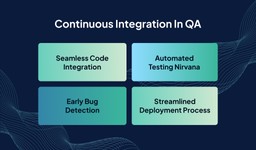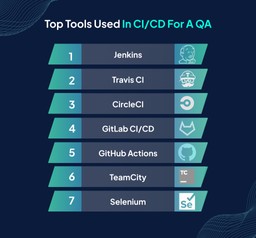Picture a scenario where the software development process flows effortlessly, catching bugs before they wreak havoc and seamlessly integrating updates without a glitch.
That’s the power of CI/CD; for QA professionals, it’s a transformative tool that enhances efficiency, productivity, and software development quality!
In this journey, we’ll explore CI/CD through the lens of QA, uncovering how it reshapes the landscape of software development, testing, and deployment.
But wait, there’s more!
Looking to make a mark in this dynamic field?
Our QA automation course is your secret weapon. It’s not just another course; it’s a unique opportunity to gain a more competitive edge in your career.
Learn how to harness the power of automation to streamline your QA processes and skyrocket your career prospects!
Now, brace yourself to unravel the secrets of maintaining top-notch quality at every stage of the development pipeline while maintaining a friendly and collaborative atmosphere.
What is Continuous Integration and Continuous Deployment?
Continuous Integration (CI) is like the glue that holds the software development process together.
It’s all about automating the process of integrating code changes from several developers into a shared repository, often numerous times a day.
This ensures that the codebase is continuously being updated and tested, reducing the likelihood of integration conflicts and catching bugs early in the development cycle.
On the other hand, Continuous Deployment (CD) takes the automation one step further by automating the deployment of code changes to production environments.
This means that whenever a new feature or bug fix is ready and passes all tests, it can be deployed to production without manual intervention. This rapid and automated deployment process increases the speed of delivering new features and reduces the risk of human error.
Together, CI/CD revolutionizes the software development lifecycle by promoting a culture of automation, collaboration, and continuous improvement.
It empowers software development teams to deliver high-quality software quickly, ultimately leading to happier customers and a competitive edge in the market.
CI/CD Examples in The Real World
With the increasing reliance on enterprise application software and the projected global revenue of 479 billion U.S. dollars by 2026, it’s clear that knowing how to fix software issues is essential.
Now, let’s explore how Continuous Integration and Continuous Deployment (CI/CD) can help ensure the reliability and quality of these software applications:
E-commerce Platform Updates
Imagine a large e-commerce platform with a team of developers constantly working on adding new features and fixing bugs.
With CI/CD in place, CI automatically triggers automated tests when a software developer pushes a code change to the central repository.
These tests cover everything from unit tests to integration tests and even user acceptance tests. If all tests pass, CD kicks in, deploying the changes to a staging environment where further testing can be conducted.
Once approved, the changes are automatically deployed to production, ensuring the platform is continuously updated with minimal downtime and maximum reliability.
Mobile App Development
In mobile app development, CI/CD ensures that updates are delivered to users quickly and seamlessly. Whenever a developer changes the app’s source code, CI automatically builds the app, runs various tests (like unit tests and UI tests), and generates a new version of the app.
This allows the development team to catch any issues early in the development process. Once the new version is approved, CD takes over, pushing the update to the respective app stores for distribution.
This rapid and automated deployment process ensures users can access the latest, most up-to-date features and bug fixes without waiting for manual updates.
Software as a Service (SaaS) Platform
For SaaS companies, maintaining high availability and reliability is paramount. CI/CD helps achieve this by automating the deployment of updates to the platform.
Whenever a new feature is developed or a bug is fixed, CI automatically runs a battery of tests to ensure the changes don’t break existing functionality.
If the tests pass, CD deploys the changes to the production environment, often using techniques like blue-green deployments or canary releases to minimize user impact. This continuous delivery pipeline allows SaaS companies to iterate quickly, respond to customer feedback, and stay ahead of the competition.
Continuous Integration in QA
Continuous Integration in QA is like having a vigilant guardian overseeing the entire software testing development process, ensuring that every code change is seamlessly integrated and thoroughly tested.
Here’s a closer look at what CI in QA entails:
Seamless Code Integration
In the fast-paced world of software development, multiple developers often work on different features simultaneously. With Continuous Integration in QA, every code change is automatically integrated into a shared repository multiple times daily.
This ensures that the latest code changes are continuously integrated into the main codebase, minimizing integration conflicts and reducing the risk of code “silos.”
As a result, teams can collaborate more effectively, and developers can focus on writing code without worrying about breaking the build.
Automated Testing Nirvana
Testing is important to ensure software quality, but it can be time-consuming and error-prone if done manually. Continuous Integration in QA revolutionizes testing by automating the process from start to finish.
Automated tests are triggered whenever a code change is submitted, covering everything from unit tests to integration tests and beyond.
These tests run in parallel, providing rapid feedback on the quality of the code changes. By automating testing as part of the CI process, QA teams can catch bugs early, maintain a high level of code quality, and accelerate the delivery of software updates.
Early Bug Detection
Bugs are the bane of every developer’s existence, but with Continuous Integration in QA, they’re no match for your testing prowess.
By running automated tests continuously throughout the development process, CI enables QA teams to detect and fix bugs early before they can wreak havoc in production. This early bug detection reduces the time and effort required for debugging and ensures a smoother and more reliable software release.
Streamlined Deployment Process
Continuous Integration in QA sets the stage for Continuous Deployment (CD) by ensuring that every code change is thoroughly tested and ready for deployment.
By integrating testing into the CI pipeline, QA teams can have confidence that the software meets quality standards before it’s deployed to production.
This streamlines the deployment process, reduces the risk of deployment failures, and enables teams to deliver updates to users more frequently and reliably.
Continuous Deployment in QA
Continuous Deployment in QA is the cherry on top of the CI/CD cake, the final piece of the puzzle that ensures your software journey reaches its destination seamlessly.
Here’s how it works:
Automated Deployment Magic
Imagine a world where deploying new code changes to production is as easy as pressing a button—no manual intervention, no late-night deployment marathons.
That’s the magic of Continuous Deployment in QA!
With CD, every code change that passes all tests in the CI pipeline is automatically deployed to production environments. This deployment process saves time and effort and lowers the risk of human error, ensuring that your software updates are rolled out quickly and efficiently.
Rapid Feedback Loop
In the fast-paced world of software development, speed is everything. With Continuous Deployment in QA, you can get your updates into users’ hands faster than ever before.
Whether it’s a critical bug fix or a game-changing new feature, CD enables you to deliver value to your users at the speed of light.
With automated rollback mechanisms in place, you can rest assured that if anything takes the wrong turn, you can quickly revert to a stable version, keeping downtime to a minimum and maintaining a stellar user experience.
Real-world Testing Playground
Production environments are the ultimate testing ground for your software. With Continuous Deployment in QA, you can gather real-world feedback from users in real-time, allowing you to identify and address issues.
Whether performance bottlenecks, usability quirks, or unforeseen edge cases, CD enables you to iterate quickly and continuously improve your software based on real user data.
It’s like having a 24/7 focus group at your fingertips, helping you refine your product and stay ahead of the competition.
Continuous Innovation
With Continuous Deployment in QA, there’s no limit to what you can achieve. CD fosters a culture of innovation and experimentation by streamlining the deployment process and empowering teams to deliver updates rapidly and frequently.
Whether experimenting with new features, optimizing existing functionality, or exploring new markets, the CD gives you the agility and flexibility to adapt to customer needs and market trends.
It’s innovation on steroids, enabling you to push the boundaries of what’s possible and stay ahead of the curve.
Top Tools Used in CI/CD for a QA
The right tools are crucial when implementing Continuous Integration and Continuous Deployment (CI/CD) for Quality Assurance (QA).
Here are some of the top tools used in CI/CD for QA professionals:
- Jenkins: Jenkins is one of the most popular open-source automation servers used for CI/CD. It provides various plugins and integrations, making it highly customizable and suitable for various workflows. Jenkins allows you to automate the entire CI/CD pipeline, from code integration and testing to deployment and monitoring.
- Travis CI: Travis CI is a cloud-based CI/CD service that integrates seamlessly with GitHub repositories. It’s known for the simplicity and ease of use, making it a great choice for small to medium-sized projects. Travis CI supports various programming languages and frameworks, making it versatile for different development environments.
- CircleCI: CircleCI is a cloud-based CI/CD platform that offers speed and scalability for automating software development workflows. It provides support for Docker containers, enabling you to both build and test applications in isolated environments. CircleCI also offers powerful features like parallelism and caching to optimize build times and increase productivity.
- GitLab CI/CD: GitLab CI/CD is part of the GitLab platform and provides native CI/CD capabilities integrated into the GitLab repository management system. It offers a single interface for managing code, CI/CD pipelines, and collaboration, streamlining the development process. GitLab CI/CD supports features like auto-scaling, review apps, and Kubernetes integration for deploying containerized applications.
- GitHub Actions: GitHub Actions is a CI/CD service provided by GitHub that offers native integration with GitHub repositories. It allows you to define workflows using YAML syntax directly in your repository, making it easy to automate build, test, and deployment tasks. GitHub Actions provides a vast range of pre-built actions and allows for seamless integration with third-party tools and services.
- TeamCity: JetBrains developed TeamCity, a powerful CI/CD server known for its user-friendly interface and robust feature set. It supports a variety of build runners, version control systems, and testing frameworks, making it suitable for diverse development environments. TeamCity offers features like build pipelines, build history, and extensive reporting capabilities for tracking build progress and performance.
- Selenium: It’s an open-source automated testing framework for web application testing. It supports multiple programming languages and browsers, letting QA professionals create automated tests for web applications easily. Selenium integrates seamlessly with CI/CD pipelines, enabling automated regression testing as the overall part of the development workflow.
Such tools represent just a glimpse of the vast landscape of CI/CD tools available to QA professionals. Depending on your specific requirements, project scope, and team preferences, you may choose to explore other tools and platforms to streamline your CI/CD processes and elevate your software development practices to new heights.
How to Get Started with CI/CD as a QA
Getting started with Continuous Integration and Continuous Deployment (CI/CD) as a Quality Assurance (QA) professional might initially seem daunting, but fear not!
Here’s a step-by-step guide to help you embark on your CI/CD journey:
- Understand the Basics: Begin by familiarizing yourself with the fundamental concepts of CI/CD. Learn about the principles behind continuous integration, continuous deployment, and the CI/CD pipeline. Understand how automated testing fits into the CI/CD process and its importance in ensuring software quality.
- Choose Your Tools: Next, explore the various tools and technologies available for implementing CI/CD. Look for tools that support your existing development environment and are compatible with your team’s workflows. Popular CI/CD tools include Jenkins, Travis CI, CircleCI, GitLab CI/CD, and GitHub Actions.
- Set Up Your Environment: Once you’ve selected your CI/CD tools, it’s time to set up your environment. Install and configure the necessary software, such as version control systems (e.g., Git), build automation tools, and testing frameworks. Collaborate with your development team to ensure seamless integration with existing workflows and processes.
- Define Your CI/CD Pipeline: Design your CI/CD pipeline to reflect your team’s development and testing processes. Determine the stages of the pipeline, such as code compilation, automated testing, code analysis, and deployment to production. Define the criteria for triggering each stage, such as code commits, pull requests, or scheduled builds.
- Automate Testing: As a QA professional, your expertise lies in testing. Leverage automation frameworks to create automated test suites that cover different aspects of the application, including unit tests, integration tests, and end-to-end tests. Integrate these tests into your CI/CD pipeline to make sure that every code change is thoroughly tested before deployment.
- Monitor and Iterate: Continuous improvement is key to successful CI/CD implementation. Monitor the performance of your CI/CD pipeline and ensure to gather feedback from stakeholders to identify areas for improvement. Iterate your pipeline to optimize performance, enhance reliability, and streamline the development process.
- Stay Updated: The field of CI/CD is constantly evolving, with new tools and best practices emerging regularly. Stay updated on the trends and developments in CI/CD by attending conferences, participating in online forums, and engaging with the broader software development community.
Accelerate Your QA Career with Syntax Technologies
Embracing Continuous Integration and Continuous Deployment in Quality Assurance (QA) is essential for staying ahead in today’s fast-paced software development landscape.
By automating testing processes, streamlining deployment pipelines, and fostering a culture of continuous improvement, CI/CD enables QA professionals to deliver high-quality software faster and more efficiently than ever before.
At Syntax Technologies, we understand the importance of staying ahead of the curve in your QA career.
That’s why we offer a professional course to equip you with the practical skills you need to succeed in the industry. Our course is packed with hands-on exercises, real-world scenarios, and in-demand skills highly sought after in today’s software industry.
With Syntax Technologies, you can accelerate your career as a QA professional and unlock new opportunities in the ever-evolving world of software development.
So why wait?
Enroll Now, take the next step in your QA journey with Syntax Technologies, and embark on a path to success in the dynamic and rewarding field of software quality assurance!



